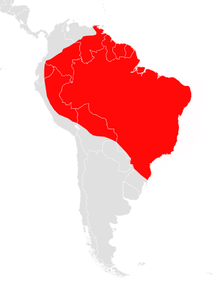Dark fruit vampire
| Dark fruit vampire | ||||||||||||
|---|---|---|---|---|---|---|---|---|---|---|---|---|
| Systematics | ||||||||||||
|
||||||||||||
| Scientific name | ||||||||||||
| Artibeus obscurus | ||||||||||||
| ( Schinz , 1821) |
The dark fruit vampire ( Artibeus obscurus ) is a species of bat from the family of leaf noses (Phyllostomidae), which is native to South America.
description
The dark fruit vampire is similar in size and appearance to the Jamaican fruit bat ( Artibeus jamaicensis ), but is not found in the same area. The average weight is 35 g, the total length 80 mm. The females are slightly larger than the males (sexual dimorphism ). Artibeus obscurus is darker and has longer fur than Artibeus jamaicensis , the fur color varies from black-brown to dark brown, with a lighter belly region. The nasal blade is long and wide, the forearms are hairy, facial stripes are weak or nonexistent.
Way of life
The dark fruit vampire occurs in a wide variety of habitats, from the rainforest of the Amazon basin to the savannah landscapes of eastern Bolivia , as well as in gardens and plantations. During the day, the animals sleep individually or in small groups under leaves, which, unlike other species of the actual fruit vampires, are not modified. The dark fruit vampire is a fruit eater. Pregnant and lactating females often visit mineral leak points in the Amazon basin , probably in order to absorb harmful phytochemicals by absorbing minerals.
Mating takes place between September and November. Pregnant and lactating females were caught in different regions at different times, which is why no precise statement can be made about the gestation time.
distribution and habitat
The dark fruit vampire is in the Amazon basin , as well as in adjacent habitats from Venezuela to Colombia , Ecuador , Peru , Bolivia to the south of Brazil . Thanks to its widespread use, the IUCN classifies its population as safe.
Web link
literature
- MA Haynes, TE Lee: Artibeus obscurus , Mammalian Species , No. 752 (2004): pp. 1-5. - doi : 10.1644 / 752
swell
- ↑ CC Voigt, KA Caps, DKN Dechmann, RH Michner, TH Kunz (2008): Nutrition or Detoxification: Why Bats Visit Mineral Licks of the Amazonian Rainforest. Plos One, 3, e2011. - doi : 10.1371 / journal.pone.0002011
- ↑ Artibeus obscurus in the IUCN Red List of Threatened Species .
